This article is joint work with Dr. John Newhook of Dalhousie University.
This past weekend featured Provincial men’s and women’s championships in most of the Canadian provinces, and what was interesting to me was the number of teams who switched to Balance Plus brush heads for their respective territorial championships. As one example, Saskatchewan hosted the combined men’s and women’s provincial championships in Kindersley. All four of the teams in the men’s and women’s CURLSASK finals are regularly Hardline users (if not sponsored by the company). However, during Provincials two of the teams – Steve Laycock on the men’s side, and Nancy Martin on the women’s side – switched to using Balance Plus RS or RS XL brush heads with prismatic Hardline Hybrid handles. This situation was the reverse of a number of instances last season that saw teams (Kaitlyn Lawes in particular) use Balance Plus LiteSpeed handles with an IcePad brush head.
While we are some ways away from performing systematic, scientific testing of the new Balance Plus 2.0 “Black” and Goldline Pursuer foams, nonetheless teams Laycock and Martin, along with several others, were clearly leaving nothing to chance and believed that the switch to Balance Plus heads was advantageous and trumped all other considerations. Mixing-and-matching brush heads and handles is permitted by World Curling, and some manufacturers, such as Hardline, make it easier by shipping plastic adapters with each new brush head that permit a better fit with other handles with a larger interior diameter (see photo at right).
Team Laycock has been using Hardline Hybrid handles for several seasons, preferring them over Hardline’s carbon fibre (but tapered). In addition to the trade-off of grip, the other trade-off is one of weight; the Helium is 260 grams, 82 grams more than Hardline’s carbon-fibre offering. So in this, the last article in our series on brush handles, we look the trade-off of brush handle mass and handle stiffness, and consider the combined weight of a brush and a compatible brush head so that the reader has a more informed idea of the characteristics of the various models in the market.
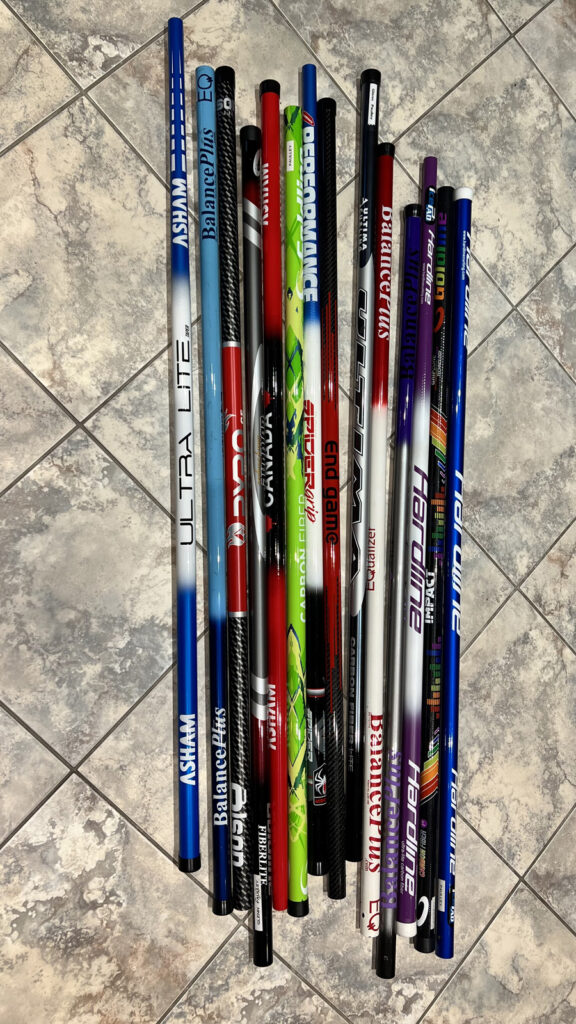
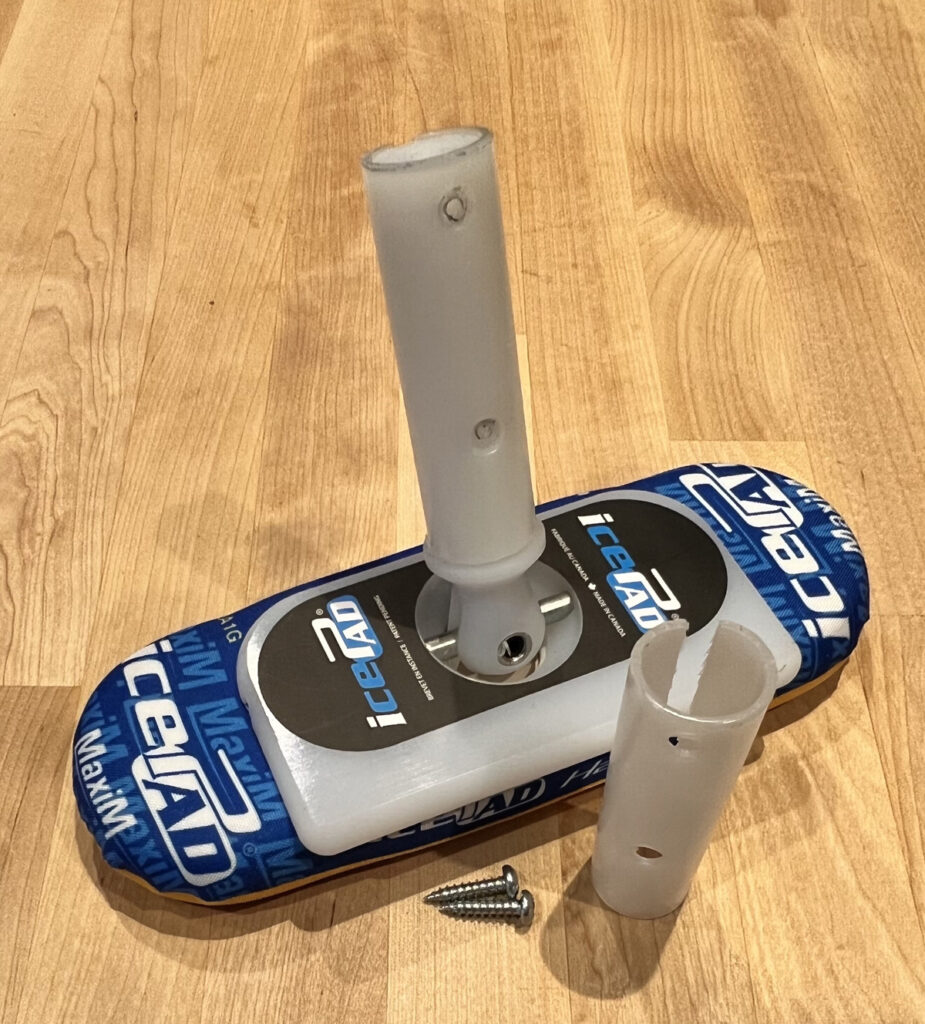
Flex-to-weight trade-off
Below, we expand on our prior article to analyze the flex-to-weight tradeoff of the brush handles that we tested. If the reader wishes to consider mixing-and-matching a brush head to a different handle, choosing a handle with the same mandrel size is straightforward, and with an adapter one can use almost any handle with any brush head, though the ease of installation does depend on the handle/head combination.
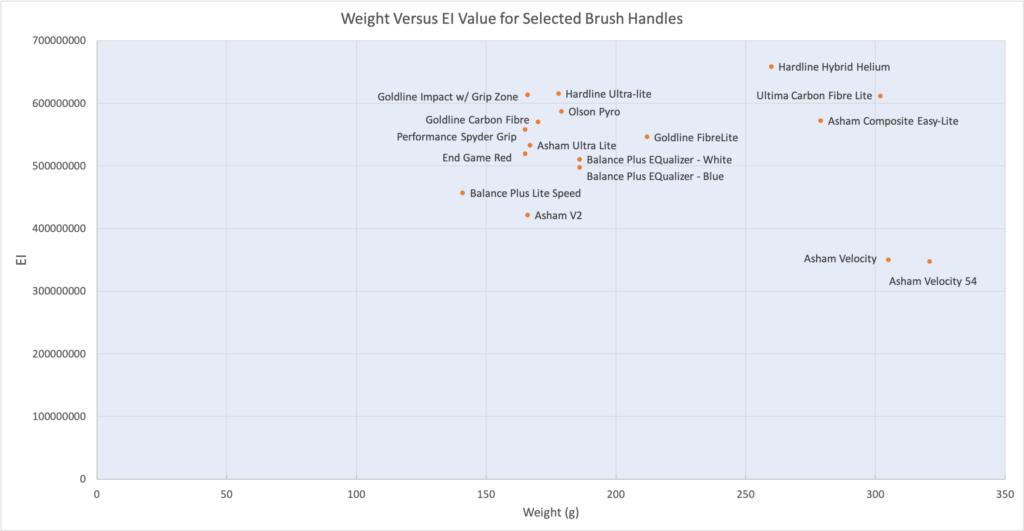
Above: a chart illustrating the trade-offs of flexibility and weight in our collection of tested brush handles from a variety of manufacturers. The top-left quadrant includes those brushes with greater rigidity and lower mass, with the Goldline Impact having the best combination of high rigidity and low mass. The bottom right quadrant has brushes with lower rigidity and greater mass; in our sample, the Asham Velocity handles have more than 50% higher mass than the lightest handles in the set. In our experience, that difference in weight will be noticed by the athlete.
Below: a comparison of brush weights, using typical combinations of brush handle/brush head offered by a single supplier. Note the considerable variation in the product offerings. However, weight alone is only one factor in the choice of a brush. Brush head weights are replicated in the table below. Details regarding the physical dimensions and weights of brush heads can be found in a prior article.
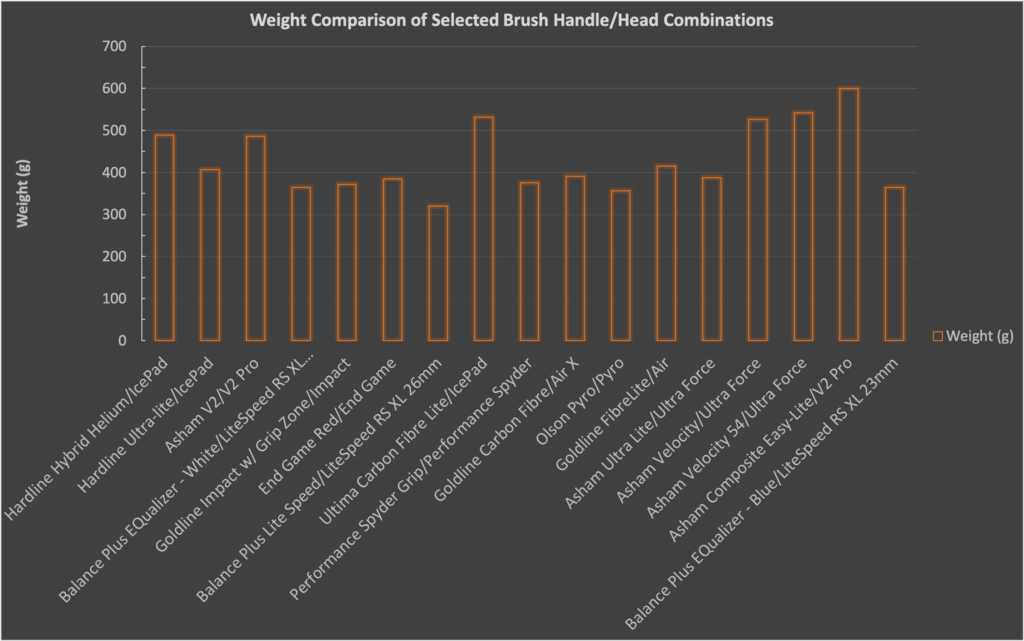
| Manufacturer | Model | Weight (g) | Prismatic? | Brush Head | Weight (g) | Total (g) |
|---|---|---|---|---|---|---|
| Hardline | Hybrid Helium | 260 | Y | IcePad | 229 | 489 |
| Hardline | Ultra-lite | 178 | N | IcePad | 229 | 407 |
| Goldline | Impact w/ Grip Zone | 166 | Y | Impact | 205 | 371 |
| Ultima | Carbon Fibre Lite | 302 | Y | IcePad | 229 | 531 |
| Olson | Pyro | 179 | Y | Pyro | 177 | 356 |
| Asham | Composite Easy-Lite | 280 | Y | V2 Pro | 320 | 599 |
| Goldline | Carbon Fibre | 170 | Y | Air X | 221 | 391 |
| Performance | Spyder Grip | 165 | N | Spyder | 211 | 376 |
| Goldline | FibreLite | 212 | Y | Air | 203 | 415 |
| Asham | Ultra Lite (Taper) | 167 | N | Ultra Force | 221 | 388 |
| End Game | Red | 165 | Y | End Game | 220 | 385 |
| Balance Plus | EQualizer - White | 186 | N | LiteSpeed RS XL 23mm | 178 | 364 |
| Balance Plus | EQualizer - Blue | 186 | N | LiteSpeed RS XL 23mm | 178 | 364 |
| Balance Plus | Lite Speed | 141 | N | LiteSpeed RS XL 26mm | 179 | 320 |
| Asham | V2 | 166 | N | V2 Pro | 320 | 486 |
| Asham | Velocity | 306 | Y | Ultra Force | 221 | 526 |
| Asham | Velocity (54 inches) | 321 | Y | Ultra Force | 221 | 542 |
| Mean | 208.8 | 430 | ||||
| Median | 179 | 391 | ||||
| Standard Deviation | 59.5 | 81.4 | ||||
| Minimum | 141 | 320 | ||||
| Maximum | 321 | 599 |
The variation in weight, grip technology, diameter, mandrel size, and flex illustrates well a level of innovation desired in the brush marketplace. A potential gap is a stiff, lightweight, carbon-fibre prismatic brush handle that can accommodate 20 mm mandrel sizes or slightly larger brush head mandrels with adaptors. In my view, grip is the most important factor, not mass, but grip is a more difficult characteristic to quantify because the size and strength of the athlete’s hands plays a role.
As for the “business end” of a curling brush – the brush head assembly, including the pad – there exists again a degree of variation which has concerned many in the curling community in recent weeks, euphemistically termed “foamgate”. In addition to the foam used in a brush head, the construction of the head assembly yields quite dissimilar pressure distributions. The photo at right shows the dirt/wear pattern for five different brush pads. From our laboratory testing, the dirt patterns are indicative of the pressure distributions for each brush head. In future articles, we hope to shed additional light on the characteristics of brush heads that influence stone behaviours.
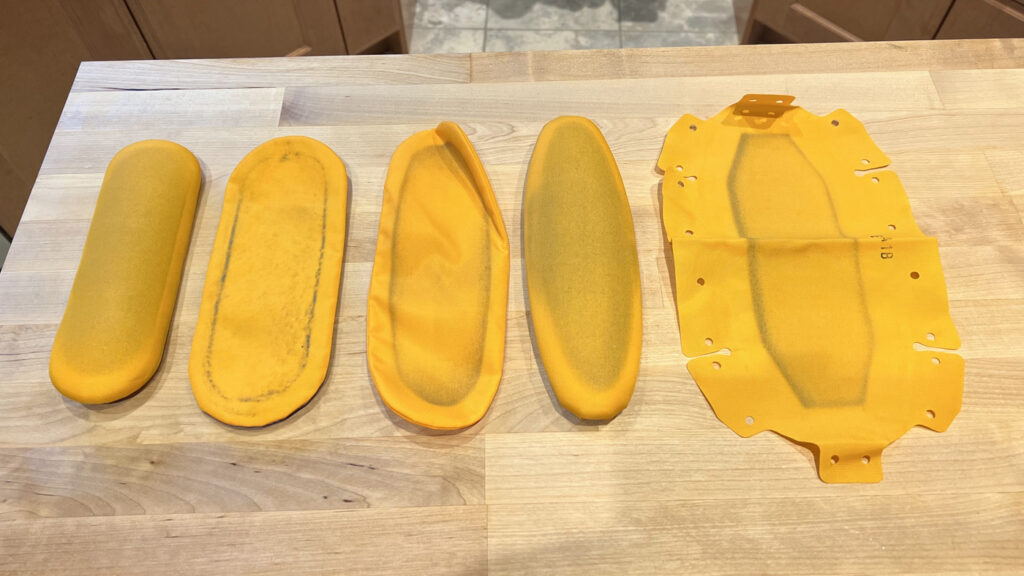
Evidence of dirt/wear on five different World Curling-approved brush head pads. From left-to-right: Goldline Air, Hardline IcePad, Balance Plus RS XL, Goldline Oval, and End Game.